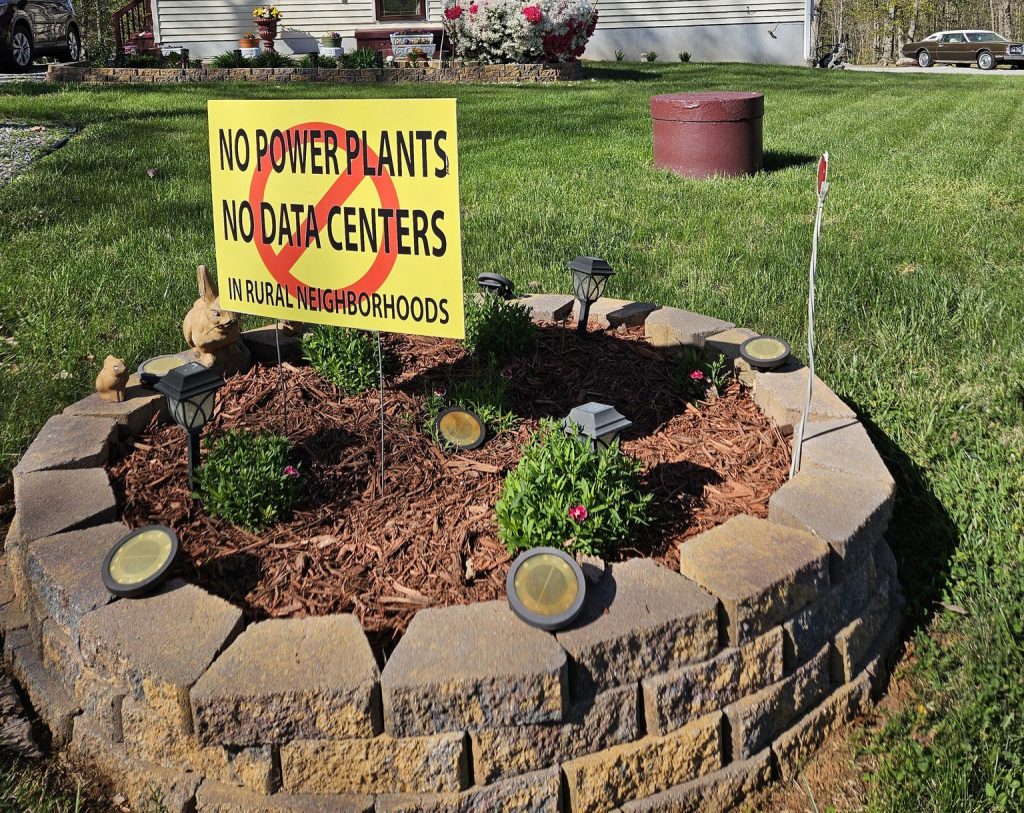Remaking Downtowns
By Dan Radmacher
Across Appalachia, communities are striving to bring new energy to downtowns that have suffered as once-dominant industries have collapsed or moved away, populations have declined and downtown businesses have shuttered.

The downtown center of Roanoke, Va., is home to a number of museums, including institutions dedicated to art, science, astronomy, African-American history and the history of Western Virginia. Photo courtesy of Creative Dog Media – Visit Virginia’s Blue Ridge.
Roanoke, Va., faced that situation in the 1970s. Its downtown was a seedy, dilapidated place. In a 2016 Politico article about Roanoke’s resurgence, Roanoke Times editorial page editor Dwayne Yancey said of downtown in that era, “Decent people didn’t go there.”
A revitalization effort began in the late 1970s. The City Market Building, a once-bustling indoor marketplace down to its last few vendors, was turned into a food court. The creation of Elmwood Park provided some much-needed public green space. A 1920s building across from the City Market Building was renovated into Center in the Square and became home to several museums and the Mill Mountain Theater.
But in 1982, the Roanoke-headquartered Norfolk & Western Railway merged with the Southern Railway, and the new Norfolk Southern moved its headquarters to Norfolk. Roanoke, which had been a company town for more than a century, suddenly lost its company — and its identity.
The Hotel Roanoke — the iconic railroad-owned Tudor-style hotel where executives once stayed — was closed. Downtown revitalization efforts stalled. When Darlene Burcham was hired as city manager in 2000, she came to a city she says was mourning the past rather than thinking of the future.
“I felt like the city was stuck in neutral,” she says. “Everyone was bemoaning the fact that Norfolk Southern had moved its headquarters rather than looking to the future. The population was declining.”
Part of the problem was a lack of attractive housing stock within the city. “I had an assistant city manager who wanted to live in a townhouse or a condo and literally couldn’t find one in the city,” Burcham says. “One of the first things we did as a city was to jump start the whole housing issue.”
The city redeveloped the pair of old Norfolk-Southern office buildings across the railroad tracks from downtown into an adult education center and an apartment building.
Ed Walker, a young lawyer turned real estate developer, began a series of renovations of old commercial buildings into downtown apartments, starting with the Colonial American Bank Building that he converted to upscale condominiums, followed by more affordable apartments in the old Grand Piano and Furniture Company. Suddenly, downtown was coming alive not just as a retail, dining and entertainment district, but as a place to live.
The biggest development for Roanoke in recent years is the collaboration between Virginia Tech and Carilion Health Clinic, which partnered to open a medical school in Roanoke in 2010. That has turned into a growing biomedical research institute, creating hundreds of high-paid jobs and attracting talented researchers and physicians while continuing to expand.
According to Richard Rife, a local architect and a member of the city planning commission when the city updated its comprehensive plan in 2000, the establishment of the medical school was “dumb luck” — but luck the city helped bring on itself.
“Maybe we made our luck by having things going in a direction that you could attract the level of people that thing’s attracting,” he says. “The success of the comprehensive plan was understanding who we are and who we aren’t. We weren’t trying to be Asheville, but we were trying to be the best Roanoke we could be.”
A Thriving Downtown
According to Shane Barton, downtown revitalization coordinator for the University of Kentucky’s Community and Economic Development Initiative of Kentucky, other communities should look to Roanoke as a model. “If anything, Roanoke has shown the power of creating more connections,” he says.
The initiative brought together a team of academic and community specialists to focus on community revitalization in eight counties in Kentucky, according to Barton. Roanoke’s city government was often criticized for putting too much emphasis on downtown development, but Barton says in his experience, there’s good reason for concentrating efforts in the city center.
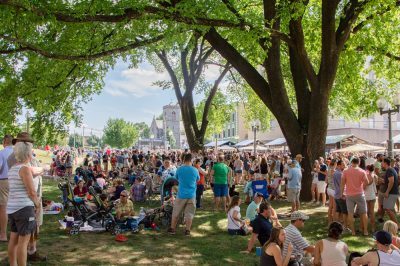
Roanoke-based Deschutes Brewery hosts an annual Street Pub event at Elmwood Park downtown where visitors can try brews while raising funds for area nonprofits. Photo courtesy of Deschutes Brewery
“We see downtowns as an intersection of all the things that are important,” he says. “They are concentrated places where different aspects of civic life and economic vitality bubble to the surface. Downtown is an opportunity to showcase who we are. They are a reflection of ourselves and how we feel about ourselves — or how people perceive that we feel about ourselves.”
Downtowns are uniquely important places, agrees Shaunna Scott, director of the Appalachian Studies Program at the University of Kentucky.
“There’s a real value to having public and common spaces where people interact,” she says. “There’s a center. There’s a place where people go. You need spaces for people to interact to do commerce, but also to make art and socialize and break bread together and worship together. That’s the thing that builds the social fabric and creates the social trust that enables your community to thrive and be resilient.”
There isn’t a cookie-cutter solution to community revitalization, according to Kaycie Stushek, community development network coordinator for the West Virginia Community Development Hub, an organization that works to improve communities in the state. “Every situation is unique, in the people and the history, the attitude, the specific challenges, the relationships, how people work together,” she says. “Every single community is at a different spot.”
Barton agrees, but says there are some commonalities in what communities need to successfully work toward revitalization. “You need an engaged and energized team of local folks,” he says. “You need to figure out who the cheerleader is, the spark in the community who can advocate for new ideas or bring new ideas to the table.”
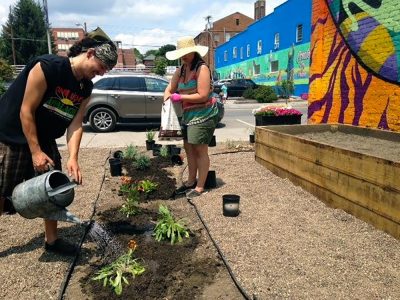
Princeton, W.Va., community members plant a garden on Mercer St. surrounded by vibrant murals. Photo courtesy of Princeton Renaissance Project.
Princeton Renaissance
In Princeton, W.Va., that spark was Lori McKinney and her partner and husband Robert Blankenship.
Like Roanoke’s downtown in the 1970s, downtown Princeton in the early 2000s was not a place people would take their families at night.
“Mercer Street had been abandoned,” says McKinney, co-founder and administrator of The RiffRaff Arts Collective. “A dark element had taken over. But that thoroughfare was a blank canvas. We located a building on the corner of 9th and Mercer and we bought it. We transformed it, turning the bottom floor into an art gallery, the second floor into art studios. We turned the top floor into a beautiful listening room, the Room Upstairs.”
Partnering with fellow artist and musician Robert Blankenship, McKinney set out to transform her home town. “I didn’t expect to come back home after I graduated,” she says. “But I saw West Virginia with new eyes. I could see what the assets were, and I realized you could create wherever you are. What makes a city great is people doing things and making cool things happen.”
The RiffRaff was a center of creative energy, but more was going on. McKinney’s sister Melissa opened Stages Music School. Working with the West Virginia Community Development Hub, the community launched the Princeton Renaissance Project, bringing together leaders from nonprofits, the Princeton-Mercer Chamber of Commerce, local banks and educational institutions and local government to work together on Princeton’s revitalization.
The Princeton Renaissance Project was key, uniting a coalition of people working together with a common vision, according to McKinney. “That was how the major transformative projects became possible,” she says.
Stephanie Tyree, executive director of the Hub, says ramping up community involvement right from the beginning is vital.
“Programs that expect and require huge community engagement on the front end can be very successful,” she says. “Something really interesting happens when you work with a community and say, ‘what we expect in this project is that you will have a huge number of people come in and we’re going to get you the resources to do a lot of projects.’ The idea is to throw a bunch of projects at the wall and see what sticks.”
One project that stuck in Princeton was a collection of murals on downtown buildings. “The murals were a big turning point,” says McKinney. “It’s impossible to ignore eight giant murals. It was a sweeping aesthetic shift that caused everyone to talk about downtown.”
Now downtown features a number of public arts projects, including sculptures and an artists’ alley. Events like the Mercer Monster Mash and a New Year’s Eve Downtown Countdown bring families downtown regularly. “Before this, the idea that people would bring their kids downtown to trick or treat was just off the wall,” says McKinney. “That was a paradigm shifting.”
The first step is getting the community on the same page, says Stushek. “One of the first things is to really focus the community on coming together and defining that vision together,” she says. “That way they can see that the community rising up and succeeding is more important than some of the squabbles they might have.”
When the Hub begins work with communities, “turf suppression” is a big part of the job, says Tyree.
“In those communities, no matter how big or small, there are consistently fiefdoms,” she says. “Maybe it’s just human nature. There are various groups all focused on wanting to make their community better, but they don’t want to work together. We start working through those conflicts and that basic failure to collaborate.”
Barton sees the same issues in Kentucky. “Everyone comes to the table for a different reason,” he says. “What we find is there are similar priorities that we have to acknowledge the parties value. We have to find similar or overlapping values and amplify the energy around those.”
One key to the Hub’s strategy is what Tyree calls “accompaniment.” These communities may have seen a lot of people come in with programs to attempt revitalization, according to Tyree, but they haven’t experienced an extended commitment to the community.
“When we work with a group of community volunteers, we commit to working with them as long as they need,” she says. “It’s not a programmatic commitment. If members of the community don’t end up as part of a network they can draw on for support or resources, they often end up right back where they started.”
Bringing people together is key to the ongoing efforts in McMinnville, Tenn., according to Michael Griffith, executive vice president of Security Federal Savings Bank. The small community between Nashville and Chattanooga has been working to capitalize on its location by encouraging start-up businesses downtown.
“I can’t stress enough that in a culture that relies on private capital, you need everyone working together: the tourism board, banks, city and county governments, utilities,” Griffith says.
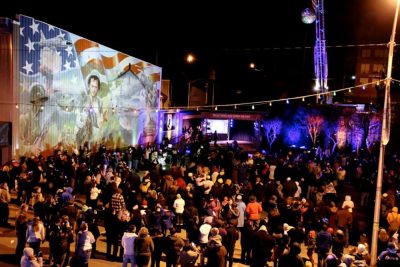
Princeton, W.Va., hosts its annual New Year’s Eve celebration in the reinvigorated downtown. Photo courtesy of Princeton Renaissance Project.
A downtown farmers’ market provided the catalyst in McMinnville, according to Griffith. “That started a hub that allowed people to congregate,” he says. “More people started shopping downtown. We realized that, though we were attracting folks from Nashville who wanted second homes and retirees from the Northeast who just love the area, downtown didn’t have all the amenities they need.”
City politicians, the local chamber of commerce and others worked together to create a tourism development board funded by a hotel/motel tax and supported by the city. They focused on renovating vacant or underutilized buildings. The city started a pilot program to provide a tax break for developers, freezing property taxes at pre-development rates for 20 years.
McMinnville also changed zoning to encourage mixed-use development and attract more downtown residents.
“If we revitalize downtown, it creates more life and people want to live here,” says Griffith. “If they want to live here, they’ll build houses and increase our tax base.”
Confronting Hurdles
Downtown revitalization in Appalachia has some special challenges, according to Tyree. One very difficult issue is tied to Appalachia’s history of absentee ownership — both of land and of buildings.
“Keystone properties on Main Streets in communities across West Virginia have been abandoned,” Tyree says. “There’s an urgency to that challenge because those properties have been abandoned and left open to the elements for decades. We’re moving into the time period where the opportunity to revitalize those properties is swiftly closing. Some are becoming public health hazards. Some are literally falling down.”
Scott, the University of Kentucky professor, agrees. “It’s a property ownership issue,” she says. “People or companies own these buildings and parcels of land that have no intention of doing anything with them. I don’t know why. Maybe they don’t want to sell short. They want to hold onto it for the next boom when they can make their fortune. That’s an obstacle to development.”
Condemning the buildings and tearing them down is one solution, but city governments hesitate to go that route, for good reason, according to Tyree. “Tearing them down is a solution that creates holes — physical holes in the downtown area,” she says. “It also creates fear in the community — fear that there’s not a strategy or the resources to put in new buildings, fear that if you start down that pathway, it leads to the community going away. It severs the emotional connections that people have to a place and their commitment to the community.”
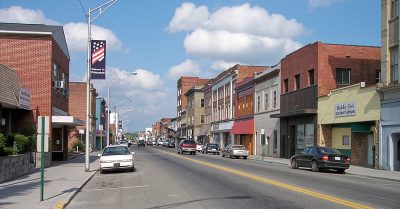
West Virginia Route 20 becomes Mercer St. in downtown Princeton, pictured here in 2007. Photo by Tim Kiser
The Hub’s Stushek says one key to dealing with this issue is developing an inventory of vacant buildings and figuring out who owns what, what buildings are for sale, what condition they’re in and who has a relationship with the owners. “Every time somebody asks about a particular property, someone should be writing a letter to the landowner detailing the interest in the property so they know they could be doing something with it,” she says. “The city can promote buildings for sale on the city website or Facebook page. Do the promotion the landowners can’t afford to do.”
“As with much of central Appalachia, we have communities where there’s a memory of a more vibrant era,” says Tyree. “There’s been a hollowing out of Main Street, just because people have left and businesses have shut down. The big question is how do you do community revitalization in a community that was built up for two or three times the number of people it currently has?”
Figuring that out can be a significant challenge and takes a lot of community conversation about infrastructure, along with vision and political leadership, according to Tyree.
The widespread poverty across Appalachia also creates a difficult challenge. “We need people who have the personal resources to volunteer their time to improve their communities,” says Tyree. “Poverty, along with the opioid addiction crisis, just decimates capacity in individual communities.”
Community revitalization experts agree that there is no one solution, no silver bullet to guarantee the resuscitation of a downtown. But the attempt is important, for the health of communities and people.
“Downtowns are a place to get out of the isolation that we as individuals sometimes feel,” says Scott. “By and large, I get more meaning and happiness when I’m collaborating and with people I like, love, respect and care about. That’s what makes me healthy and happy, and that’s what makes communities healthy and happy. Appalachia needs to reinvigorate the notion of the commons, a space that can bring benefit to us all.”
Related Articles
Latest News

Leave a comment
Your email address will not be published. Required fields are marked *





